TPMS JEEP CHEROKEE 2020 Owner handbook (in English)
[x] Cancel search | Manufacturer: JEEP, Model Year: 2020, Model line: CHEROKEE, Model: JEEP CHEROKEE 2020Pages: 332, PDF Size: 8.87 MB
Page 9 of 332
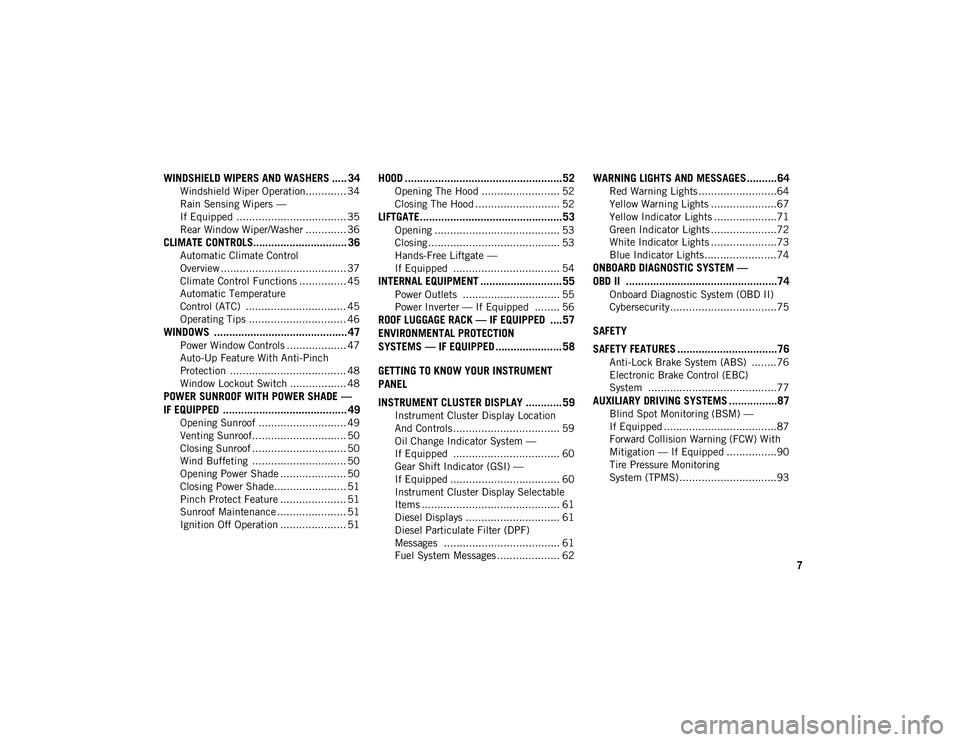
7
WINDSHIELD WIPERS AND WASHERS ..... 34
Windshield Wiper Operation............. 34
Rain Sensing Wipers —
If Equipped ................................... 35 Rear Window Wiper/Washer ............. 36
CLIMATE CONTROLS............................... 36
Automatic Climate Control
Overview ........................................ 37 Climate Control Functions ............... 45
Automatic Temperature
Control (ATC) ................................ 45 Operating Tips ............................... 46
WINDOWS ............................................ 47
Power Window Controls ................... 47
Auto-Up Feature With Anti-Pinch
Protection ..................................... 48 Window Lockout Switch .................. 48
POWER SUNROOF WITH POWER SHADE —
IF EQUIPPED ......................................... 49
Opening Sunroof ............................ 49
Venting Sunroof.............................. 50
Closing Sunroof .............................. 50
Wind Buffeting .............................. 50
Opening Power Shade ..................... 50
Closing Power Shade....................... 51
Pinch Protect Feature ..................... 51
Sunroof Maintenance ...................... 51
Ignition Off Operation ..................... 51
HOOD ....................................................52
Opening The Hood ......................... 52
Closing The Hood ........................... 52
LIFTGATE...............................................53
Opening ........................................ 53
Closing .......................................... 53
Hands-Free Liftgate —
If Equipped .................................. 54
INTERNAL EQUIPMENT ........................... 55
Power Outlets ............................... 55
Power Inverter — If Equipped ........ 56
ROOF LUGGAGE RACK — IF EQUIPPED ....57
ENVIRONMENTAL PROTECTION
SYSTEMS — IF EQUIPPED ...................... 58
GETTING TO KNOW YOUR INSTRUMENT
PANEL
INSTRUMENT CLUSTER DISPLAY ............ 59
Instrument Cluster Display Location
And Controls .................................. 59 Oil Change Indicator System —
If Equipped .................................. 60 Gear Shift Indicator (GSI) —
If Equipped ................................... 60 Instrument Cluster Display Selectable
Items ............................................ 61 Diesel Displays .............................. 61
Diesel Particulate Filter (DPF)
Messages ..................................... 61 Fuel System Messages .................... 62
WARNING LIGHTS AND MESSAGES ..........64
Red Warning Lights .........................64
Yellow Warning Lights .....................67
Yellow Indicator Lights ....................71
Green Indicator Lights .....................72
White Indicator Lights .....................73
Blue Indicator Lights .......................74
ONBOARD DIAGNOSTIC SYSTEM —
OBD II ..................................................74
Onboard Diagnostic System (OBD II)
Cybersecurity..................................75
SAFETY
SAFETY FEATURES .................................76
Anti-Lock Brake System (ABS) ........76
Electronic Brake Control (EBC)
System .........................................77
AUXILIARY DRIVING SYSTEMS ................87
Blind Spot Monitoring (BSM) —
If Equipped ....................................87 Forward Collision Warning (FCW) With
Mitigation — If Equipped ................90 Tire Pressure Monitoring
System (TPMS)...............................93
2020_JEEP_CHEROKEE_UG_RHD_UK.book Page 7
Page 72 of 332
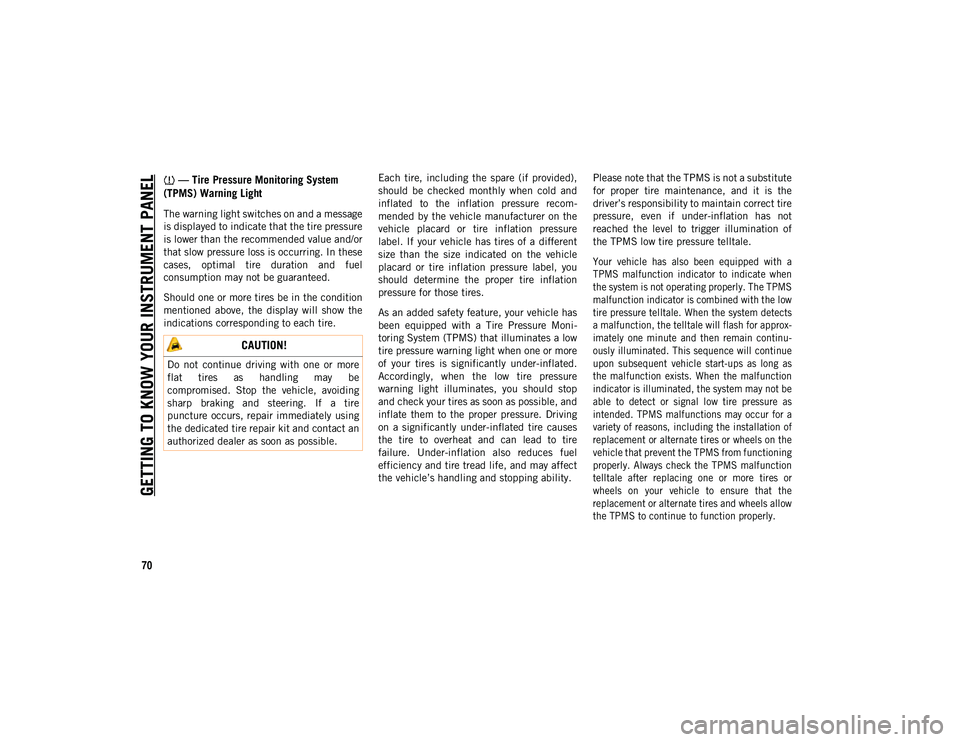
GETTING TO KNOW YOUR INSTRUMENT PANEL
70
— Tire Pressure Monitoring System
(TPMS) Warning Light
The warning light switches on and a message
is displayed to indicate that the tire pressure
is lower than the recommended value and/or
that slow pressure loss is occurring. In these
cases, optimal tire duration and fuel
consumption may not be guaranteed.
Should one or more tires be in the condition
mentioned above, the display will show the
indications corresponding to each tire. Each tire, including the spare (if provided),
should be checked monthly when cold and
inflated to the inflation pressure recom
-
mended by the vehicle manufacturer on the
vehicle placard or tire inflation pressure
label. If your vehicle has tires of a different
size than the size indicated on the vehicle
placard or tire inflation pressure label, you
should determine the proper tire inflation
pressure for those tires.
As an added safety feature, your vehicle has
been equipped with a Tire Pressure Moni -
toring System (TPMS) that illuminates a low
tire pressure warning light when one or more
of your tires is significantly under-inflated.
Accordingly, when the low tire pressure
warning light illuminates, you should stop
and check your tires as soon as possible, and
inflate them to the proper pressure. Driving
on a significantly under-inflated tire causes
the tire to overheat and can lead to tire
failure. Under-inflation also reduces fuel
efficiency and tire tread life, and may affect
the vehicle’s handling and stopping ability. Please note that the TPMS is not a substitute
for proper tire maintenance, and it is the
driver’s responsibility to maintain correct tire
pressure, even if under-inflation has not
reached the level to trigger illumination of
the TPMS low tire pressure telltale.
Your vehicle has also been equipped with a
TPMS malfunction indicator to indicate when
the system is not operating properly. The TPMS
malfunction indicator is combined with the low
tire pressure telltale. When the system detects
a malfunction, the telltale will flash for approx
-
imately one minute and then remain continu -
ously illuminated. This sequence will continue
upon subsequent vehicle start-ups as long as
the malfunction exists. When the malfunction
indicator is illuminated, the system may not be
able to detect or signal low tire pressure as
intended. TPMS malfunctions may occur for a
variety of reasons, including the installation of
replacement or alternate tires or wheels on the
vehicle that prevent the TPMS from functioning
properly. Always check the TPMS malfunction
telltale after replacing one or more tires or
wheels on your vehicle to ensure that the
replacement or alternate tires and wheels allow
the TPMS to continue to function properly.
CAUTION!
Do not continue driving with one or more
flat tires as handling may be
compromised. Stop the vehicle, avoiding
sharp braking and steering. If a tire
puncture occurs, repair immediately using
the dedicated tire repair kit and contact an
authorized dealer as soon as possible.
2020_JEEP_CHEROKEE_UG_RHD_UK.book Page 70
Page 73 of 332
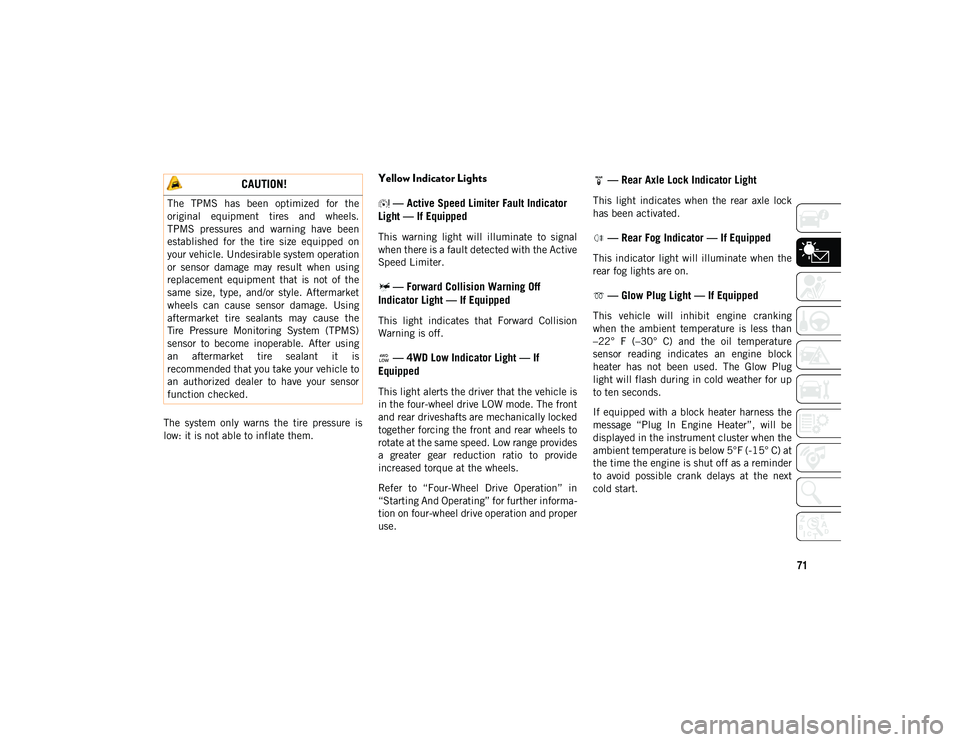
71
The system only warns the tire pressure is
low: it is not able to inflate them.
Yellow Indicator Lights — Active Speed Limiter Fault Indicator
Light — If Equipped
This warning light will illuminate to signal
when there is a fault detected with the Active
Speed Limiter.
— Forward Collision Warning Off
Indicator Light — If Equipped
This light indicates that Forward Collision
Warning is off.
— 4WD Low Indicator Light — If
Equipped
This light alerts the driver that the vehicle is
in the four-wheel drive LOW mode. The front
and rear driveshafts are mechanically locked
together forcing the front and rear wheels to
rotate at the same speed. Low range provides
a greater gear reduction ratio to provide
increased torque at the wheels.
Refer to “Four-Wheel Drive Operation” in
“Starting And Operating” for further informa -
tion on four-wheel drive operation and proper
use.
— Rear Axle Lock Indicator Light
This light indicates when the rear axle lock
has been activated.
— Rear Fog Indicator — If Equipped
This indicator light will illuminate when the
rear fog lights are on.
— Glow Plug Light — If Equipped
This vehicle will inhibit engine cranking
when the ambient temperature is less than
–22° F (–30° C) and the oil temperature
sensor reading indicates an engine block
heater has not been used. The Glow Plug
light will flash during in cold weather for up
to ten seconds.
If equipped with a block heater harness the
message “Plug In Engine Heater”, will be
displayed in the instrument cluster when the
ambient temperature is below 5°F (-15° C) at
the time the engine is shut off as a reminder
to avoid possible crank delays at the next
cold start.
CAUTION!
The TPMS has been optimized for the
original equipment tires and wheels.
TPMS pressures and warning have been
established for the tire size equipped on
your vehicle. Undesirable system operation
or sensor damage may result when using
replacement equipment that is not of the
same size, type, and/or style. Aftermarket
wheels can cause sensor damage. Using
aftermarket tire sealants may cause the
Tire Pressure Monitoring System (TPMS)
sensor to become inoperable. After using
an aftermarket tire sealant it is
recommended that you take your vehicle to
an authorized dealer to have your sensor
function checked.
2020_JEEP_CHEROKEE_UG_RHD_UK.book Page 71
Page 95 of 332
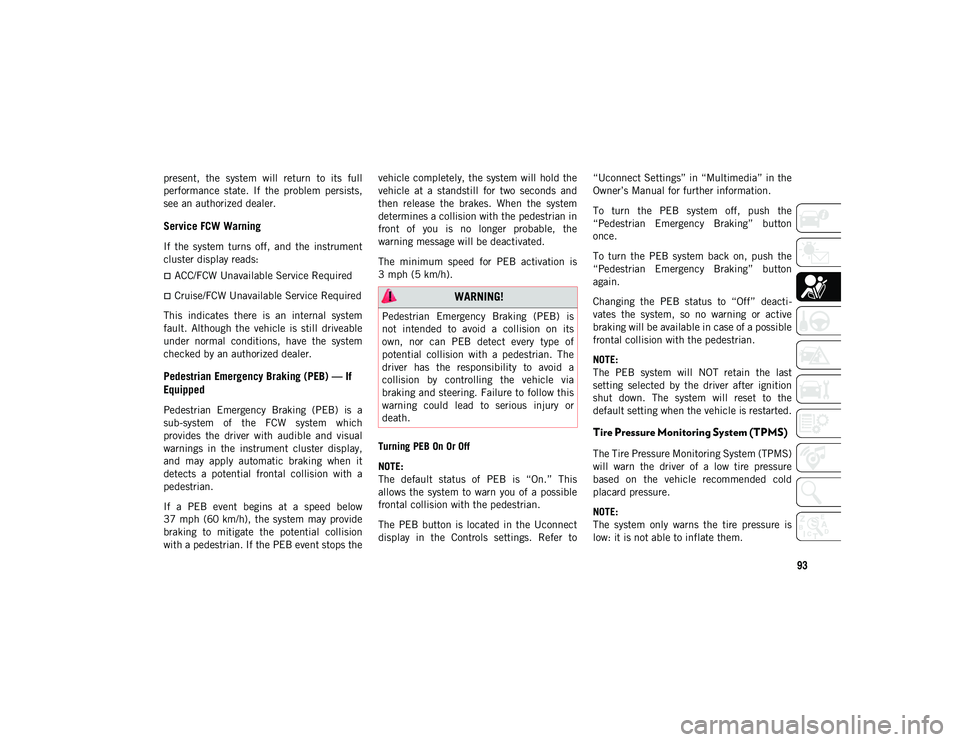
93
present, the system will return to its full
performance state. If the problem persists,
see an authorized dealer.
Service FCW Warning
If the system turns off, and the instrument
cluster display reads:
ACC/FCW Unavailable Service Required
Cruise/FCW Unavailable Service Required
This indicates there is an internal system
fault. Although the vehicle is still driveable
under normal conditions, have the system
checked by an authorized dealer.
Pedestrian Emergency Braking (PEB) — If
Equipped
Pedestrian Emergency Braking (PEB) is a
sub-system of the FCW system which
provides the driver with audible and visual
warnings in the instrument cluster display,
and may apply automatic braking when it
detects a potential frontal collision with a
pedestrian.
If a PEB event begins at a speed below
37 mph (60 km/h), the system may provide
braking to mitigate the potential collision
with a pedestrian. If the PEB event stops the vehicle completely, the system will hold the
vehicle at a standstill for two seconds and
then release the brakes. When the system
determines a collision with the pedestrian in
front of you is no longer probable, the
warning message will be deactivated.
The minimum speed for PEB activation is
3 mph (5 km/h).
Turning PEB On Or Off
NOTE:
The default status of PEB is “On.” This
allows the system to warn you of a possible
frontal collision with the pedestrian.
The PEB button is located in the Uconnect
display in the Controls settings. Refer to
“Uconnect Settings” in “Multimedia” in the
Owner’s Manual for further information.
To turn the PEB system off, push the
“Pedestrian Emergency Braking” button
once.
To turn the PEB system back on, push the
“Pedestrian Emergency Braking” button
again.
Changing the PEB status to “Off” deacti
-
vates the system, so no warning or active
braking will be available in case of a possible
frontal collision with the pedestrian.
NOTE:
The PEB system will NOT retain the last
setting selected by the driver after ignition
shut down. The system will reset to the
default setting when the vehicle is restarted.
Tire Pressure Monitoring System (TPMS)
The Tire Pressure Monitoring System (TPMS)
will warn the driver of a low tire pressure
based on the vehicle recommended cold
placard pressure.
NOTE:
The system only warns the tire pressure is
low: it is not able to inflate them.
WARNING!
Pedestrian Emergency Braking (PEB) is
not intended to avoid a collision on its
own, nor can PEB detect every type of
potential collision with a pedestrian. The
driver has the responsibility to avoid a
collision by controlling the vehicle via
braking and steering. Failure to follow this
warning could lead to serious injury or
death.
2020_JEEP_CHEROKEE_UG_RHD_UK.book Page 93
Page 96 of 332
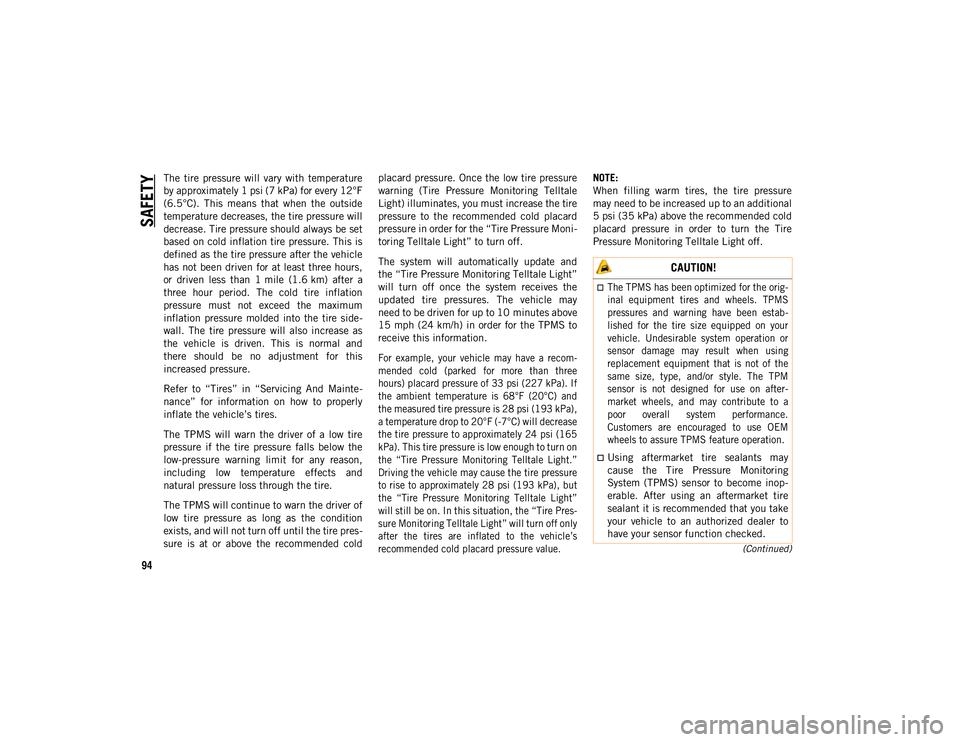
SAFETY
94
(Continued)
The tire pressure will vary with temperature
by approximately 1 psi (7 kPa) for every 12°F
(6.5°C). This means that when the outside
temperature decreases, the tire pressure will
decrease. Tire pressure should always be set
based on cold inflation tire pressure. This is
defined as the tire pressure after the vehicle
has not been driven for at least three hours,
or driven less than 1 mile (1.6 km) after a
three hour period. The cold tire inflation
pressure must not exceed the maximum
inflation pressure molded into the tire side-
wall. The tire pressure will also increase as
the vehicle is driven. This is normal and
there should be no adjustment for this
increased pressure.
Refer to “Tires” in “Servicing And Mainte -
nance” for information on how to properly
inflate the vehicle’s tires.
The TPMS will warn the driver of a low tire
pressure if the tire pressure falls below the
low-pressure warning limit for any reason,
including low temperature effects and
natural pressure loss through the tire.
The TPMS will continue to warn the driver of
low tire pressure as long as the condition
exists, and will not turn off until the tire pres -
sure is at or above the recommended cold placard pressure. Once the low tire pressure
warning (Tire Pressure Monitoring Telltale
Light) illuminates, you must increase the tire
pressure to the recommended cold placard
pressure in order for the “Tire Pressure Moni
-
toring Telltale Light” to turn off.
The system will automatically update and
the “Tire Pressure Monitoring Telltale Light”
will turn off once the system receives the
updated tire pressures. The vehicle may
need to be driven for up to 10 minutes above
15 mph (24 km/h) in order for the TPMS to
receive this information.
For example, your vehicle may have a recom -
mended cold (parked for more than three
hours) placard pressure of 33 psi (227 kPa). If
the ambient temperature is 68°F (20°C) and
the measured tire pressure is 28 psi (193 kPa),
a temperature drop to 20°F (-7°C) will decrease
the tire pressure to approximately 24 psi (165
kPa). This tire pressure is low enough to turn on
the “Tire Pressure Monitoring Telltale Light.”
Driving the vehicle may cause the tire pressure
to rise to approximately 28 psi (193 kPa), but
the “Tire Pressure Monitoring Telltale Light”
will still be on. In this situation, the “Tire Pres -
sure Monitoring Telltale Light” will turn off only
after the tires are inflated to the vehicle’s
recommended cold placard pressure value.
NOTE:
When filling warm tires, the tire pressure
may need to be increased up to an additional
5 psi (35 kPa) above the recommended cold
placard pressure in order to turn the Tire
Pressure Monitoring Telltale Light off.
CAUTION!
The TPMS has been optimized for the orig
-
inal equipment tires and wheels. TPMS
pressures and warning have been estab -
lished for the tire size equipped on your
vehicle. Undesirable system operation or
sensor damage may result when using
replacement equipment that is not of the
same size, type, and/or style. The TPM
sensor is not designed for use on after -
market wheels, and may contribute to a
poor overall system performance.
Customers are encouraged to use OEM
wheels to assure TPMS feature operation.
Using aftermarket tire sealants may
cause the Tire Pressure Monitoring
System (TPMS) sensor to become inop -
erable. After using an aftermarket tire
sealant it is recommended that you take
your vehicle to an authorized dealer to
have your sensor function checked.
2020_JEEP_CHEROKEE_UG_RHD_UK.book Page 94
Page 97 of 332
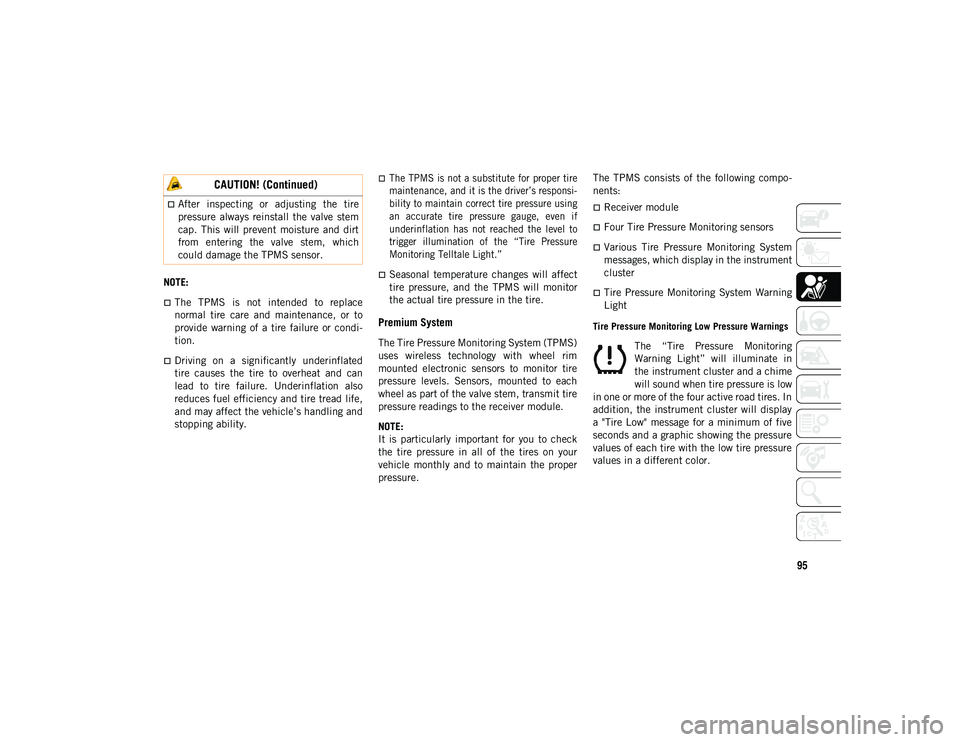
95
NOTE:
The TPMS is not intended to replace
normal tire care and maintenance, or to
provide warning of a tire failure or condi-
tion.
Driving on a significantly underinflated
tire causes the tire to overheat and can
lead to tire failure. Underinflation also
reduces fuel efficiency and tire tread life,
and may affect the vehicle’s handling and
stopping ability.
The TPMS is not a substitute for proper tire
maintenance, and it is the driver’s responsi -
bility to maintain correct tire pressure using
an accurate tire pressure gauge, even if
underinflation has not reached the level to
trigger illumination of the “Tire Pressure
Monitoring Telltale Light.”
Seasonal temperature changes will affect
tire pressure, and the TPMS will monitor
the actual tire pressure in the tire.
Premium System
The Tire Pressure Monitoring System (TPMS)
uses wireless technology with wheel rim
mounted electronic sensors to monitor tire
pressure levels. Sensors, mounted to each
wheel as part of the valve stem, transmit tire
pressure readings to the receiver module.
NOTE:
It is particularly important for you to check
the tire pressure in all of the tires on your
vehicle monthly and to maintain the proper
pressure. The TPMS consists of the following compo
-
nents:
Receiver module
Four Tire Pressure Monitoring sensors
Various Tire Pressure Monitoring System
messages, which display in the instrument
cluster
Tire Pressure Monitoring System Warning
Light
Tire Pressure Monitoring Low Pressure Warnings
The “Tire Pressure Monitoring
Warning Light” will illuminate in
the instrument cluster and a chime
will sound when tire pressure is low
in one or more of the four active road tires. In
addition, the instrument cluster will display
a "Tire Low" message for a minimum of five
seconds and a graphic showing the pressure
values of each tire with the low tire pressure
values in a different color.
After inspecting or adjusting the tire
pressure always reinstall the valve stem
cap. This will prevent moisture and dirt
from entering the valve stem, which
could damage the TPMS sensor.
CAUTION! (Continued)
2020_JEEP_CHEROKEE_UG_RHD_UK.book Page 95
Page 98 of 332
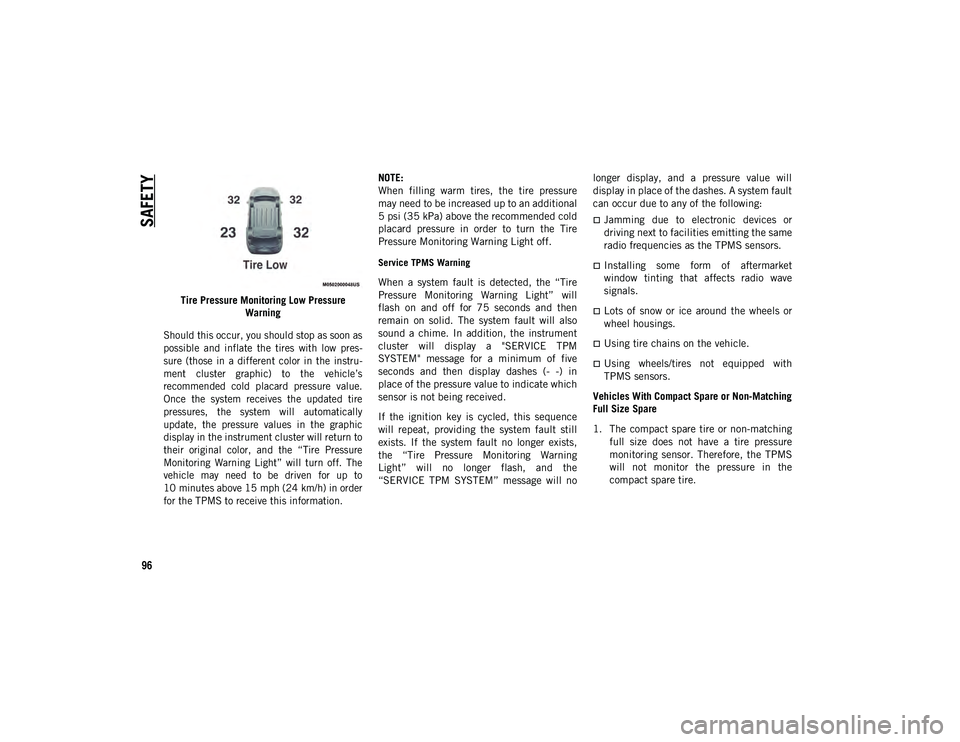
SAFETY
96
Tire Pressure Monitoring Low Pressure Warning
Should this occur, you should stop as soon as
possible and inflate the tires with low pres -
sure (those in a different color in the instru -
ment cluster graphic) to the vehicle’s
recommended cold placard pressure value.
Once the system receives the updated tire
pressures, the system will automatically
update, the pressure values in the graphic
display in the instrument cluster will return to
their original color, and the “Tire Pressure
Monitoring Warning Light” will turn off. The
vehicle may need to be driven for up to
10 minutes above 15 mph (24 km/h) in order
for the TPMS to receive this information.
NOTE:
When filling warm tires, the tire pressure
may need to be increased up to an additional
5 psi (35 kPa) above the recommended cold
placard pressure in order to turn the Tire
Pressure Monitoring Warning Light off.
Service TPMS Warning
When a system fault is detected, the “Tire
Pressure Monitoring Warning Light” will
flash on and off for 75 seconds and then
remain on solid. The system fault will also
sound a chime. In addition, the instrument
cluster will display a "SERVICE TPM
SYSTEM" message for a minimum of five
seconds and then display dashes (- -) in
place of the pressure value to indicate which
sensor is not being received.
If the ignition key is cycled, this sequence
will repeat, providing the system fault still
exists. If the system fault no longer exists,
the “Tire Pressure Monitoring Warning
Light” will no longer flash, and the
“SERVICE TPM SYSTEM” message will no
longer display, and a pressure value will
display in place of the dashes. A system fault
can occur due to any of the following:
Jamming due to electronic devices or
driving next to facilities emitting the same
radio frequencies as the TPMS sensors.
Installing some form of aftermarket
window tinting that affects radio wave
signals.
Lots of snow or ice around the wheels or
wheel housings.
Using tire chains on the vehicle.
Using wheels/tires not equipped with
TPMS sensors.
Vehicles With Compact Spare or Non-Matching
Full Size Spare
1. The compact spare tire or non-matching full size does not have a tire pressure
monitoring sensor. Therefore, the TPMS
will not monitor the pressure in the
compact spare tire.
2020_JEEP_CHEROKEE_UG_RHD_UK.book Page 96
Page 99 of 332

97
2. If you install the compact ornon-matching full size spare tire in place
of a road tire that has a pressure below
the low-pressure warning limit, upon the
next ignition key cycle, the “TPMS
Warning Light” will remain on and a
chime will sound. In addition, the
graphic in the instrument cluster will still
display a different color pressure value.
3. After driving the vehicle for up to 10 minutes above 15 mph (24 km/h),
the “TPMS Warning Light” will flash on
and off for 75 seconds and then remain
on solid. In addition, the instrument
cluster will display a “Service Tire Pres -
sure System” message for five seconds
and then display dashes (- -) in place of
the pressure value.
4. For each subsequent ignition key cycle, a chime will sound, the “TPMS Warning0
Light” will flash on and off for 75
seconds and then remain on solid, and
the instrument cluster will display a
“SERVICE TPM SYSTEM” message for
five seconds and then display dashes (- -)
in place of the pressure value. 5. Once you repair or replace the original
road tire and reinstall it on the vehicle
in place of the compact spare or
non-matching full size, the TPMS will
update automatically. In addition, the
“TPMS Warning Light” will turn off and
the graphic in the instrument cluster
will display a new pressure value
instead of dashes (- -), as long as no
tire pressure is below the low-pressure
warning limit in any of the four active
road tires. The vehicle may need to be
driven for up to 10 minutes above
15 mph (24 km/h) in order for the
TPMS to receive this information.
TPMS Deactivation — If Equipped
The TPMS can be deactivated if replacing all
four wheel and tire assemblies (road tires)
with wheel and tire assemblies that do not
have TPMS Sensors, such as when installing
winter wheel and tire assemblies on your
vehicle.
To deactivate the TPMS, first replace all
four wheel and tire assemblies (road tires)
with tires not equipped with Tire Pressure
Monitoring (TPM) sensors. Then, drive the
vehicle for 10 minutes above 15 mph
(24 km/h). The TPMS will chime, the "TPM Telltale Light" will flash on and off for 75
seconds and then remain on. The instru
-
ment cluster will display the “SERVICE
TPM SYSTEM” message and then display
dashes (--) in place of the pressure values.
Beginning with the next ignition cycle, the
TPMS will no longer chime or display the
“SERVICE TPM SYSTEM” message in the
instrument cluster but dashes (--) will
remain in place of the pressure values.
To reactivate the TPMS, replace all four
wheel and tire assemblies (road tires) with
tires equipped with TPM sensors. Then, drive
the vehicle for up to 10 minutes above
15 mph (24 km/h). The TPMS will chime,
the "TPM Telltale Light" will flash on and off
for 75 seconds and then turn off. The instru -
ment cluster will display the “SERVICE TPM
SYSTEM” message and then display pres -
sure values in place of the dashes. On the
next ignition cycle the "SERVICE TPM
SYSTEM" message will no longer be
displayed as long as no system fault exists.
2020_JEEP_CHEROKEE_UG_RHD_UK.book Page 97
Page 327 of 332
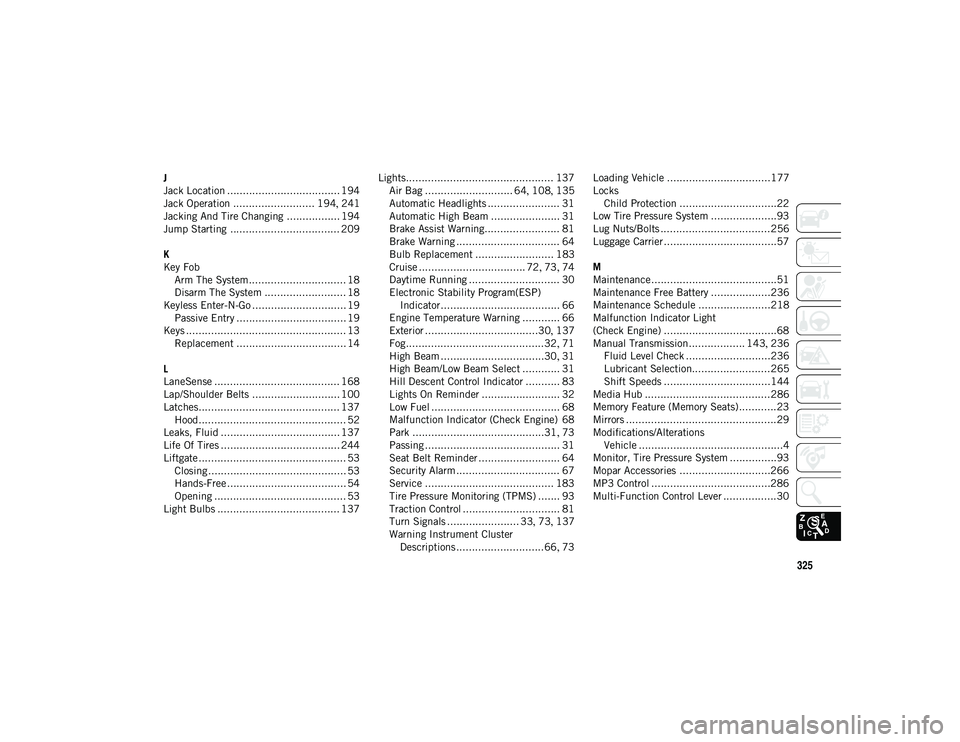
325
J
Jack Location .................................... 194
Jack Operation .......................... 194, 241
Jacking And Tire Changing ................. 194
Jump Starting ................................... 209
K
Key Fob Arm The System ............................... 18
Disarm The System .......................... 18
Keyless Enter-N-Go .............................. 19 Passive Entry ................................... 19
Keys ................................................... 13 Replacement ................................... 14
L
LaneSense ........................................ 168
Lap/Shoulder Belts ............................ 100
Latches............................................. 137 Hood ............................................... 52
Leaks, Fluid ...................................... 137
Life Of Tires ...................................... 244
Liftgate ............................................... 53 Closing ............................................ 53
Hands-Free ...................................... 54
Opening .......................................... 53
Light Bulbs ....................................... 137 Lights............................................... 137
Air Bag ............................ 64 , 108 , 135
Automatic Headlights ....................... 31
Automatic High Beam ...................... 31
Brake Assist Warning........................ 81
Brake Warning ................................. 64
Bulb Replacement ......................... 183
Cruise .................................. 72 , 73 , 74
Daytime Running ............................. 30
Electronic Stability Program(ESP) Indicator...................................... 66
Engine Temperature Warning ............ 66
Exterior ....................................30 , 137
Fog............................................32 , 71
High Beam .................................30 , 31
High Beam/Low Beam Select ............ 31
Hill Descent Control Indicator ........... 83
Lights On Reminder ......................... 32
Low Fuel ......................................... 68
Malfunction Indicator (Check Engine) 68
Park ..........................................31 , 73
Passing ........................................... 31
Seat Belt Reminder .......................... 64
Security Alarm ................................. 67
Service ......................................... 183
Tire Pressure Monitoring (TPMS) ....... 93
Traction Control ............................... 81
Turn Signals ....................... 33 , 73 , 137
Warning Instrument Cluster Descriptions ............................66 , 73 Loading Vehicle .................................177
Locks
Child Protection ...............................22
Low Tire Pressure System .....................93
Lug Nuts/Bolts ...................................256
Luggage Carrier ....................................57
M
Maintenance........................................51
Maintenance Free Battery ...................236
Maintenance Schedule .......................218
Malfunction Indicator Light
(Check Engine) ....................................68
Manual Transmission.................. 143 , 236
Fluid Level Check ...........................236
Lubricant Selection.........................265
Shift Speeds ..................................144
Media Hub ........................................286
Memory Feature (Memory Seats)............23
Mirrors ................................................29
Modifications/Alterations Vehicle ..............................................4
Monitor, Tire Pressure System ...............93
Mopar Accessories .............................266
MP3 Control ......................................286
Multi-Function Control Lever .................30
2020_JEEP_CHEROKEE_UG_RHD_UK.book Page 325
Page 330 of 332
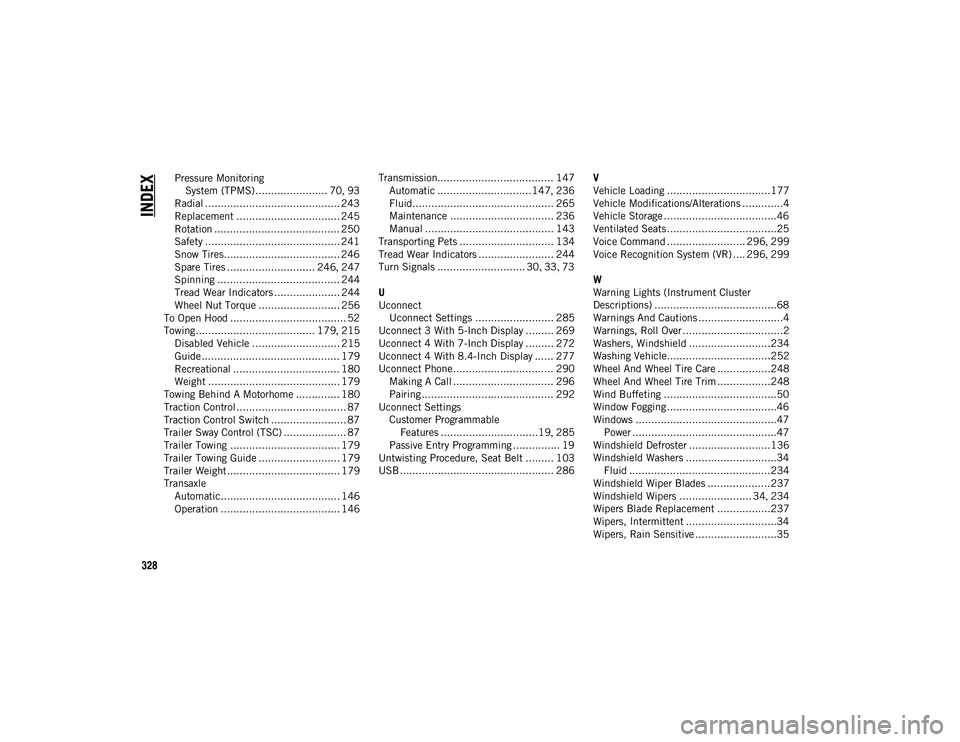
328
INDEX
Pressure Monitoring System (TPMS)....................... 70 , 93
Radial ........................................... 243
Replacement ................................. 245
Rotation ........................................ 250
Safety ........................................... 241
Snow Tires..................................... 246
Spare Tires ............................ 246 , 247
Spinning ....................................... 244
Tread Wear Indicators ..................... 244
Wheel Nut Torque .......................... 256
To Open Hood ..................................... 52
Towing...................................... 179 , 215
Disabled Vehicle ............................ 215 Guide ............................................ 179
Recreational .................................. 180
Weight .......................................... 179
Towing Behind A Motorhome .............. 180
Traction Control ................................... 87
Traction Control Switch ........................ 87
Trailer Sway Control (TSC) .................... 87
Trailer Towing ................................... 179
Trailer Towing Guide .......................... 179
Trailer Weight .................................... 179
Transaxle Automatic...................................... 146
Operation ...................................... 146 Transmission..................................... 147
Automatic ..............................147 , 236
Fluid............................................. 265
Maintenance ................................. 236
Manual ......................................... 143
Transporting Pets .............................. 134
Tread Wear Indicators ........................ 244
Turn Signals ............................ 30 , 33 , 73
U
Uconnect Uconnect Settings ......................... 285
Uconnect 3 With 5-Inch Display ......... 269
Uconnect 4 With 7-Inch Display ......... 272
Uconnect 4 With 8.4-Inch Display ...... 277
Uconnect Phone ................................ 290 Making A Call ................................ 296
Pairing .......................................... 292
Uconnect Settings Customer Programmable Features ...............................19 , 285
Passive Entry Programming ............... 19
Untwisting Procedure, Seat Belt ......... 103
USB ................................................. 286 V
Vehicle Loading .................................177
Vehicle Modifications/Alterations .............4
Vehicle Storage ....................................46
Ventilated Seats ...................................25
Voice Command ......................... 296
, 299
Voice Recognition System (VR) .... 296 , 299
W
Warning Lights (Instrument Cluster
Descriptions) .......................................68
Warnings And Cautions ...........................4
Warnings, Roll Over ................................2
Washers, Windshield ..........................234
Washing Vehicle.................................252
Wheel And Wheel Tire Care .................248
Wheel And Wheel Tire Trim .................248
Wind Buffeting ....................................50
Window Fogging ...................................46
Windows .............................................47 Power ..............................................47
Windshield Defroster ..........................136
Windshield Washers .............................34 Fluid .............................................234
Windshield Wiper Blades ....................237
Windshield Wipers ....................... 34 , 234
Wipers Blade Replacement .................237
Wipers, Intermittent .............................34
Wipers, Rain Sensitive ..........................35
2020_JEEP_CHEROKEE_UG_RHD_UK.book Page 328